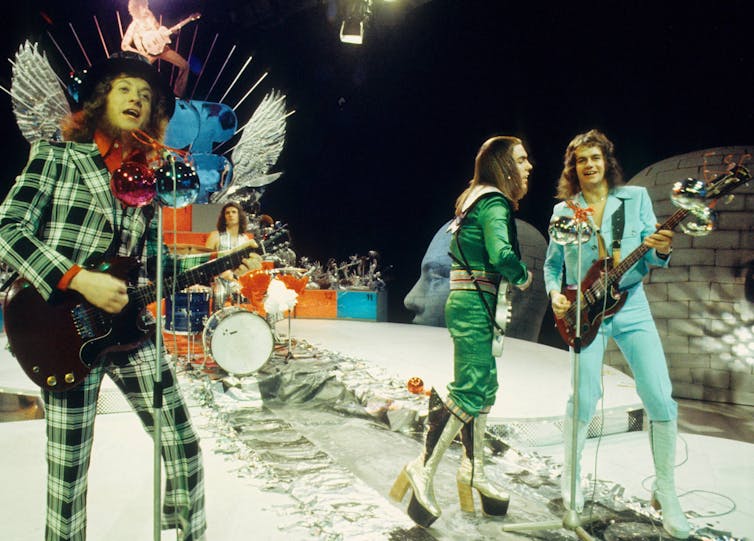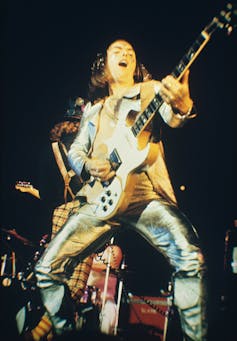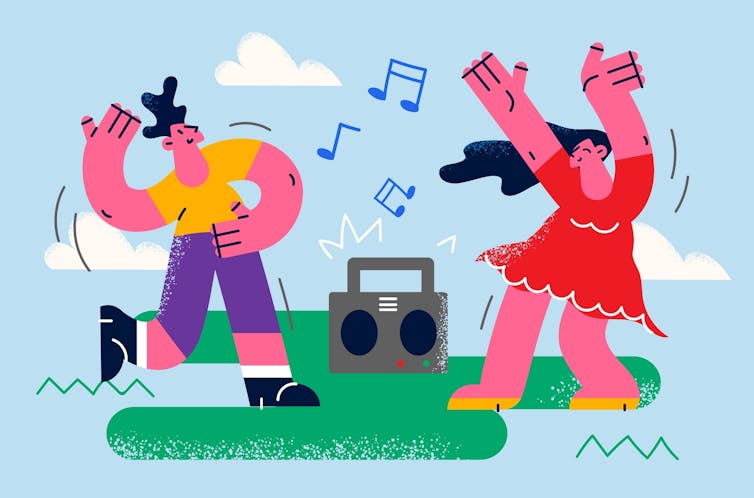
Are you hanging up your stocking on your wall?It’s the time that every Santa has a ball!
You’ve probably just heard the 1973 Slade classic at the mall or supermarket. Merry Xmas Everybody is one of the most enduring Christmas singles of all time: three-and-a-half minutes of festive rock n’ roll, it’s infectiously joyful, raucous – and, most of all, Christmassy.
Written by band members Noddy Holder and Jim Lea, Merry Xmas Everybody celebrates the exuberance of a working-class Christmas Day: waiting for family to arrive, wishing for snow, whizzing down the hill in a homemade buggy and falling off, drinking and dancing.
Even granny is “up and rock ‘n’ rolling with the rest”. Santa not only rides a red-nosed reindeer, he does “ton-ups on his sleigh”.
With its Beatles-esque refrain and harmonies, the ring of a harmonium organ and singalong chorus, Merry Xmas Everybody is far from your traditional White Christmas or Jingle Bells. It’s Slade’s Christmas, and we’re all invited:
So here it is, Merry Christmas, everybody’s having funLook to the future now, it’s only just begun.
And back in the British winter of 1973, people really did need some fun, and reason to look to the future with hope. Wage freezes, rising inflation, strikes and general discontent had made for anything but a merry Christmas.
The glam and the grim
Slade were one of the top British glam rock bands of the 1970s. With a stomping rock n’ roll sound and the high-energy, raspy vocals of Noddy Holder, they embodied no-frills party rock, tinged with a good dose of humour.
With six number one singles and 24 top tens – including glam standards like Look Wot U Dun, Mama Weer All Crazee Now, Take Me Back ‘Ome and Cum on Feel the Noize – Slade’s appeal lay in their marriage of glitter-rock sparkle and rowdy, working-class attitude.
And there was good reason for Slade’s – and glam rock’s – popularity when Merry Xmas Everybody hit big: escapism.
1973 was a tough year in Britain. Conservative prime minister Edward Heath had used the Industrial Relations Act to try to curb the trade unions’ power, triggering widespread strike action, including 1.6 million workers taking part in a one-day strike on May 1.

By November, winter was approaching. Electricity supplies relied on coal, which was now limited. A state of emergency was declared. In the cold of winter, people were instructed to switch off their heaters. Television broadcasts ended by 10.30pm.
The Trafalgar Square Christmas tree reportedly remained unlit that year, except for Christmas Day.
Just two weeks before Christmas, a three-day working week was announced, to come into effect at midnight on December 31. This would force businesses to close to conserve electricity, meaning many workers either went part-time or simply lost their jobs.
Noddy Holder has described writing Merry Xmas Everybody to give people something to enjoy in those tough times. It might not be quite the same, but after 2024’s cost-of-living pressures and plenty of political instability, the song still feels relevant today.
A half-century hit
Noddy Holder knew what he was doing. The product of a Wolverhampton council estate, he was proud of his working-class background but never took himself too seriously. He wore tartan stage costumes and an exaggerated top hat decorated with silver discs that caught the TV lights.
Guitarist Dave Hill – the most flamboyant band member – styled himself as “Super Yob”, a working-class superhero decked out in more glitter than a department store Christmas tree. They were brash, brightly costumed, and they were here to party.
Glam rock dominated the music charts in 1973, including The Sweet’s Block Buster! and Ballroom Blitz, Suzi Quatro’s Can the Can and 48 Crash, and T. Rex’s 20th Century Boy. David Bowie released Life on Mars? and The Jean Genie. And Wizzard’s See My Baby Jive went to number one – as did Slade’s Cum on Feel the Noize.
By December, Slade’s closest competition was Wizzard’s Christmas single, I Wish It Could Be Christmas Every Day, a merry, 1960s-style romp punctuated with the ironic ring of cash registers. Vocalist Roy Wood appeared on TV dressed as a bizarre glam rock Santa.
In the end, Slade won out, taking the vaunted Christmas number one slot and staying there for nine weeks. The music was a reworked psychedelic tune Holder had begun writing in 1967, with bassist Jim Lea adding the verses. The band borrowed the harmonium from John Lennon who was recording in the studio next door.
At the end of the song, Noddy screams, “It’s Chrissstmasss!”. It was an expression of joy in the face of everyday troubles, but also of solidarity and resilience. The band’s television performances of the song were euphoric.
Now, 51 years later, the song has spent over 120 weeks in the charts, often returning for several Christmases in a row. Noddy Holder, now 78, often jokes about the royalties providing his pension.
And Merry Xmas Everybody is back in the charts again this year. That’s testament to the song’s own resilience, and its timeless appeal to having a good time, even when times are tough.![]()
Alison Blair, Teaching Fellow in Music, University of Otago
This article is republished from The Conversation under a Creative Commons license. Read the original article.








